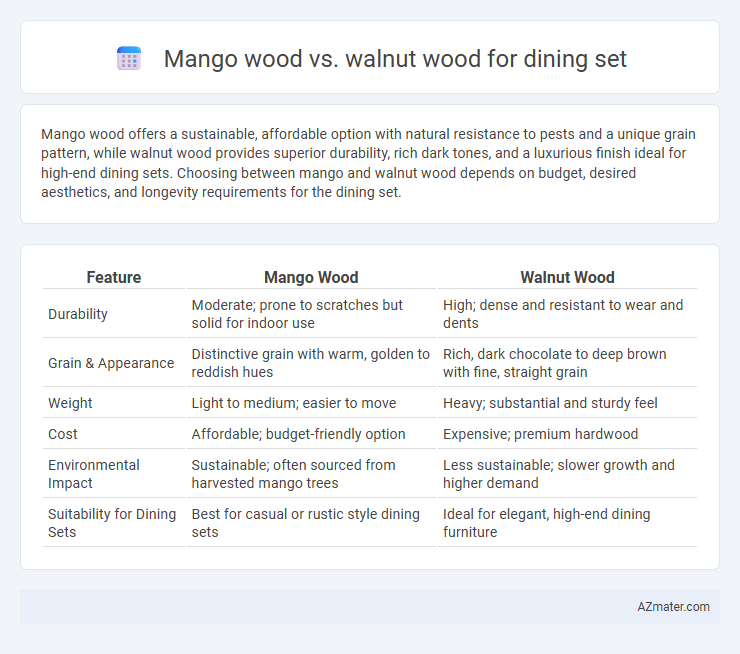Mango wood offers a sustainable, affordable option with natural resistance to pests and a unique grain pattern, while walnut wood provides superior durability, rich dark tones, and a luxurious finish ideal for high-end dining sets. Choosing between mango and walnut wood depends on budget, desired aesthetics, and longevity requirements for the dining set.
Table of Comparison
| Feature | Mango Wood | Walnut Wood |
|---|---|---|
| Durability | Moderate; prone to scratches but solid for indoor use | High; dense and resistant to wear and dents |
| Grain & Appearance | Distinctive grain with warm, golden to reddish hues | Rich, dark chocolate to deep brown with fine, straight grain |
| Weight | Light to medium; easier to move | Heavy; substantial and sturdy feel |
| Cost | Affordable; budget-friendly option | Expensive; premium hardwood |
| Environmental Impact | Sustainable; often sourced from harvested mango trees | Less sustainable; slower growth and higher demand |
| Suitability for Dining Sets | Best for casual or rustic style dining sets | Ideal for elegant, high-end dining furniture |
Introduction: Mango Wood vs Walnut Wood for Dining Sets
Mango wood and walnut wood are popular choices for dining sets, each offering distinct characteristics ideal for furniture. Mango wood is known for its durability, eco-friendliness, and unique grain patterns, making it a sustainable and visually striking option. Walnut wood stands out for its rich, dark color, smooth texture, and exceptional strength, providing a luxurious and long-lasting dining set.
Origin and Availability of Mango and Walnut Wood
Mango wood is primarily sourced from India and Southeast Asia, known for its rapid growth and sustainable harvesting, making it widely available and cost-effective for dining sets. Walnut wood originates mainly from North America and Europe, prized for its rich color and durability but is less abundant and more expensive due to slower growth and limited supply. The choice between mango and walnut wood dining sets often depends on availability, budget, and desired aesthetic, with mango offering eco-friendly accessibility and walnut providing a premium, long-lasting option.
Appearance and Grain Patterns
Mango wood exhibits a warm, golden hue with distinct, irregular grain patterns that range from straight to wavy, adding a rustic charm to dining sets. Walnut wood is prized for its rich, dark brown color with subtle purple undertones and consistently smooth, straight grain that gives a refined, elegant appearance. The unique grain variation of mango wood contrasts with the uniformity of walnut, making each option suitable for different aesthetic preferences in dining furniture.
Durability and Strength Comparison
Mango wood offers moderate durability and strength, making it suitable for budget-friendly dining sets but requiring regular maintenance to prevent wear and damage. Walnut wood provides superior durability and strength due to its dense grain and natural resistance to decay, ensuring long-lasting performance for high-end dining furniture. Walnut's robust hardness rating of 1,010 on the Janka scale outperforms mango wood's softer rating, making it ideal for heavy-use dining environments.
Maintenance and Care Requirements
Mango wood is more resistant to moisture and requires less frequent polishing, making it easier to maintain for dining sets in humid environments. Walnut wood, while offering a richer, darker finish, needs regular oiling to prevent drying and cracking over time. Both woods benefit from gentle cleaning with a damp cloth, but walnut demands more consistent care to preserve its elegant appearance.
Environmental Impact and Sustainability
Mango wood is a highly sustainable choice for dining sets due to its rapid growth and use of mango trees after fruit harvesting, reducing deforestation. Walnut wood, while durable and elegant, grows much slower and is often sourced from old-growth forests, raising concerns about long-term environmental impact. Choosing mango wood supports reforestation and responsible farming practices, making it a more eco-friendly option compared to walnut wood.
Cost and Affordability
Mango wood generally offers a more affordable option for dining sets compared to walnut wood due to its faster growth rate and abundance, making it cost-effective for budget-conscious buyers. Walnut wood, prized for its rich color, durability, and fine grain, commands a higher price point, reflecting its premium quality and slower maturation. Choosing mango wood can significantly reduce initial expenses while still providing sturdy, attractive furniture, whereas walnut suits those prioritizing long-term investment and luxury aesthetics.
Suitability for Dining Furniture
Mango wood offers durability and resistance to warping, making it suitable for dining sets that endure daily use, with a unique grain pattern that enhances rustic and contemporary decor. Walnut wood features a rich, dark finish and fine texture, providing an elegant and timeless aesthetic ideal for formal dining furniture. Both woods provide strong structural integrity, but walnut's higher cost and maintenance requirements make mango wood a more cost-effective choice for versatile dining sets.
Common Styles and Finishes
Mango wood dining sets often feature rustic and farmhouse styles, showcasing natural grain patterns with matte or satin finishes that enhance their warm, golden hues. Walnut wood dining sets commonly present classic or mid-century modern designs, with smooth finishes like oil or lacquer that emphasize the rich, dark brown tones and straight grain. Both woods accommodate a range of stains, but mango wood lends itself to lighter, distressed finishes while walnut supports deeper, polished looks.
Final Verdict: Which Wood is Best for Your Dining Set?
Mango wood offers affordability, durability, and a sustainable option with a unique grain pattern, making it ideal for budget-conscious buyers seeking rustic charm. Walnut wood features a rich, dark tone and exceptional strength but comes at a higher price, suited for those wanting a luxurious, long-lasting dining set. Choose mango wood for cost-effective style and eco-friendliness; opt for walnut wood if premium aesthetics and durability are top priorities.

Infographic: Mango wood vs Walnut wood for Dining set
 azmater.com
azmater.com